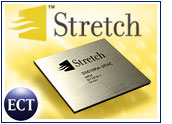
Mountain View, California-based Stretch, a fabless semiconductor developer, this week debuted a new family of process that can be configured by software, making this the first design to embed powerful programmable logic within an off-the-shelf processor.
The chip family — the S5000 — also includes a suite of development tools that let developers automatically configure and optimize the processor using only C/C++ code.
“Embedded system developers no longer need to trade off performance, time-to-market and system costs,” said Gary Banta, CEO of Stretch.
“Developers program and automatically configure our processors using pure C/C++, achieving unprecedented performance, easy and rapid development, tremendous cost savings, and the flexibility to address diverse markets and changing application needs,” he said.
Quick Customization
Banta noted that his company’s software-configurable processors can be customized quickly and easily to address compute-intensive applications in markets as diverse as the consumer, telecommunications, networking, military and medical industries.
According to Banta, the processors combine “the best of two previously divergent semiconductor worlds” — the ease of software development associated with general-purpose processors, plus the parallelism and flexibility found in other processors.
The company achieves this goal by embedding programmable logic entirely inside the processor architecture — an industry first, Banta claimed.
Every processor is powered by the S5 engine, which incorporates the widely accepted Tensilica Xtensa RISC processor core and Stretch’s Instruction Set Extension Fabric (ISEF), said the company.
Software-Configurable Data Path
The ISEF is a software-configurable data path based on proprietary programmable logic. Using the ISEF, system designers extend the processor instruction set and define the new instructions using only their C/C++ code.
As a result, said the company, developers get the performance of logic with C/C++ development simplicity — achieving unprecedented performance, easy and rapid development.
Industry experts have noted that embedded system developers are often forced to make difficult compromises when addressing compute-intensive applications, including employing banks of digital signal processors and general-purpose processors.
Developers often deploy systems with select fixed-function chips that do not allow them to address changing standards or differentiate their products.
All in the Family
The processor family already has passed one benchmarking test — for the telecom industry.
A test by the Embedded Microprocessor Benchmark Consortium (EEMBC) gave an optimized score of 2.924 Telemarks per megahertz, which translates into a score of 877 Telemarks in a 300-MHz simulation. Test results were certified by the EEMBC Certification Labs.
“Stretch’s … scores are obviously impressive. What makes this processor interesting is that this level of performance is achieved by programming in C, and the Stretch tools automatically configure the hardware,” said Markus Levy, EEMBC president. “This same approach can also be easily applied to other applications to achieve equally impressive results.”




















































